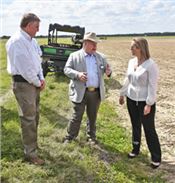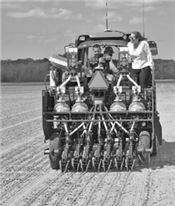|
EPA Administrators Visit LSU AgCenter Rice Station

Anne Idsal, Region 6 administrator for the U.S. Environmental Protection Agency, listens to
Mike Strain, commissioner of the Louisiana Department of Agriculture and Forestry, center, and Rogers Leonard,
LSU AgCenter associate vice president for plants, soil and water, during a visit
to the AgCenter H. Rouse Caffey Rice Research Station.
Photo by Bruce Schultz/LSU AgCenter
CROWLEY, LA.
The administrator and deputy administrator for the U.S. Environmental Protection Agency Region 6 visited the LSU AgCenter H. Rouse Caffey Rice Research Station to learn about the challenges facing farmers.
Anne Idsal, appointed by the Trump administration in December, and David Gray, deputy regional administrator, toured the station while research plots were being planted.
EPA Region 6 includes Louisiana, Texas, Arkansas, Oklahoma and New Mexico.
Rogers Leonard, LSU AgCenter associate vice president for plants, soil and water, said he hopes Idsal visits AgCenter facilities again.
“We are excited that there is considerable interest by our federal partners to visit the station and gain an understanding of the needs for Louisiana agriculture,” Leonard said. “The LSU AgCenter and the EPA’s scientists continue to collaborate and provide sustainable and environmentally acceptable solutions to our stakeholders’ challenges.”
Mike Strain, Louisiana Department of Agriculture and Forestry commissioner, told Idsal and Gray that a scale insect is threatening Roseau cane, a vital part of retaining the Louisiana coastline. “We’ve got to find a way to deal with it,” he said.
Donald Berken, a rice farmer from Jefferson Davis Parish, told Idsal and Gray about the problems farmers are facing.
“Thank you for coming out and getting educated,” Berken told them.
During the visit, Isdal recognized the working relationship between the AgCenter and LDAF. “Looks like you have a good partnership here,” she said.
AgCenter rice specialist Dustin Harrell explained the peculiarities of rice farming. He brought up the problem with blackbirds feeding on newly planted rice, and he acknowledged that the EPA recently approved the use of a chemical seed treatment for a bird repellent.
A bird repellent also is needed for mature rice, he said.
The apple snail now has the potential to be a problem for crawfish farmers, he said.
Harrell also showed the EPA officials a series of recently planted research plots to study rice grown with furrow irrigation, often referred to as row rice. He also took Idsal on a seed drill to learn how the planting is done.
AgCenter rice breeder Adam Famoso explained to Idsal and Gray how genetic screening has streamlined the selection process of potential rice lines. ∆

Farmer Donald Berken, center, tells Anne Idsal and David Gray,
both of the U.S. Environmental Protection Agency, about the challenges
he faces in producing a rice crop.

Anne Idsal, U.S. Environmental Protection Agency Region 6 administrator, watches AgCenter
rice specialist Dustin Harrell as he loads a rice planter with seed. Idsal visited the AgCenter H. Rouse Caffey Rice Research Station to
learn more about rice farming and problems facing farmers.
Photos by Bruce Schultz/LSU AgCenter
|
|